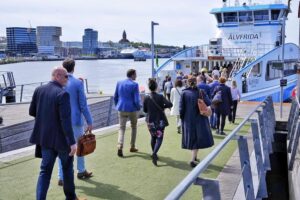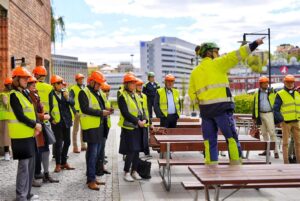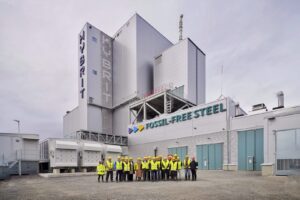A high-level delegation with 50 participants from Groningen city and region visited Sweden in May. The delegation included mayors, politicians, university, and business leaders as well as the Dutch ambassador to Sweden. Their main interest was in energy, mobility, and human capital. They visited Gothenburg, Stockholm, Luleå and Vaasa.
Mobility solutions in Gothenburg

The delegation on their way on a ferry in Gothenburg
At the first stop in Gothenburg, the focus was on mobility, including the new energy solutions at the Port of Gothenburg. The delegation then went to Lindholmen Science Park, where development projects within mobility are constantly tried out. At Lindholmen, the delegations looked at the wireless charging of taxi cars. The group from Groningen also meet with companies Nilsson Energy, Einride and Volvo Group.
Focus on energy in the Swedish capital
In Stockholm, the delegation started the day with a visit to Stockholm Waterfront, an energy-efficient building in the central of Stockholm, more than double as energy-efficient as the EU standard ‘green building’.

Learning about hydrogen and CCS at Stockholm Exergi
The visit was followed by a visit to Stockholm Exergi, where bioenergy with CCS was discussed. Thereafter, the delegation went to the Royal Seaport, one of the most sustainable districts in Sweden. The visit ended at the Dutch Embassy with presentations from the cities Stockholm and Groningen, companies Scania and Holthausen, the Dutch embassy, and the research institute RISE.
Green steel from the North
Next, the delegation travelled north to the city of Luleå. The Mayor of Luleå welcomed the delegation together with parts from Invest in Norrbotten, Luleå Technology and industry leaders. The group from Groningen got knowledge about the green transition in Northern Sweden, the BotH2nia – the Hydrogen Bay of the North and the H2 Green Steel project. After the presentations, the group visited the Hybrit Green Steel Pilot plant and the Luleå University of Technology.

The group outside Hybrit in Luleå
The Hybrit Green Steel Pilot plant is a unique joint effort between SSAB, LKAB and Vattenfall to change the Swedish iron and steel industry fundamentally by developing fossil-free steel. The HYBRIT technology has the potential to reduce Sweden’s total carbon dioxide emissions by at least 10 per cent. The delegation was eager to learn more about the enormous overcapacity in the green electricity to decarbonize heavy industry with green hydrogen and was pleased with the visit.
At the Luleå University of Technology the delegation learnt about CH2ESS; a new research and knowledge initiative with a focus on hydrogen use in industrial processes and energy systems, in close collaboration with the Swedish industry.
A trip to the neighbour
Finally, the group visited the Finnish Energy Center in Vaasa, where the focus was on hydrogen, battery production, Energy storage, Electric Flight and Human capital connected to these areas. Finland and Sweden´s collaboration was also mentioned and the willingness to develop collaboration with Groningen. Companies from Sweden and Finland were also part of the program and could present their solutions to the Groningen industry leaders.